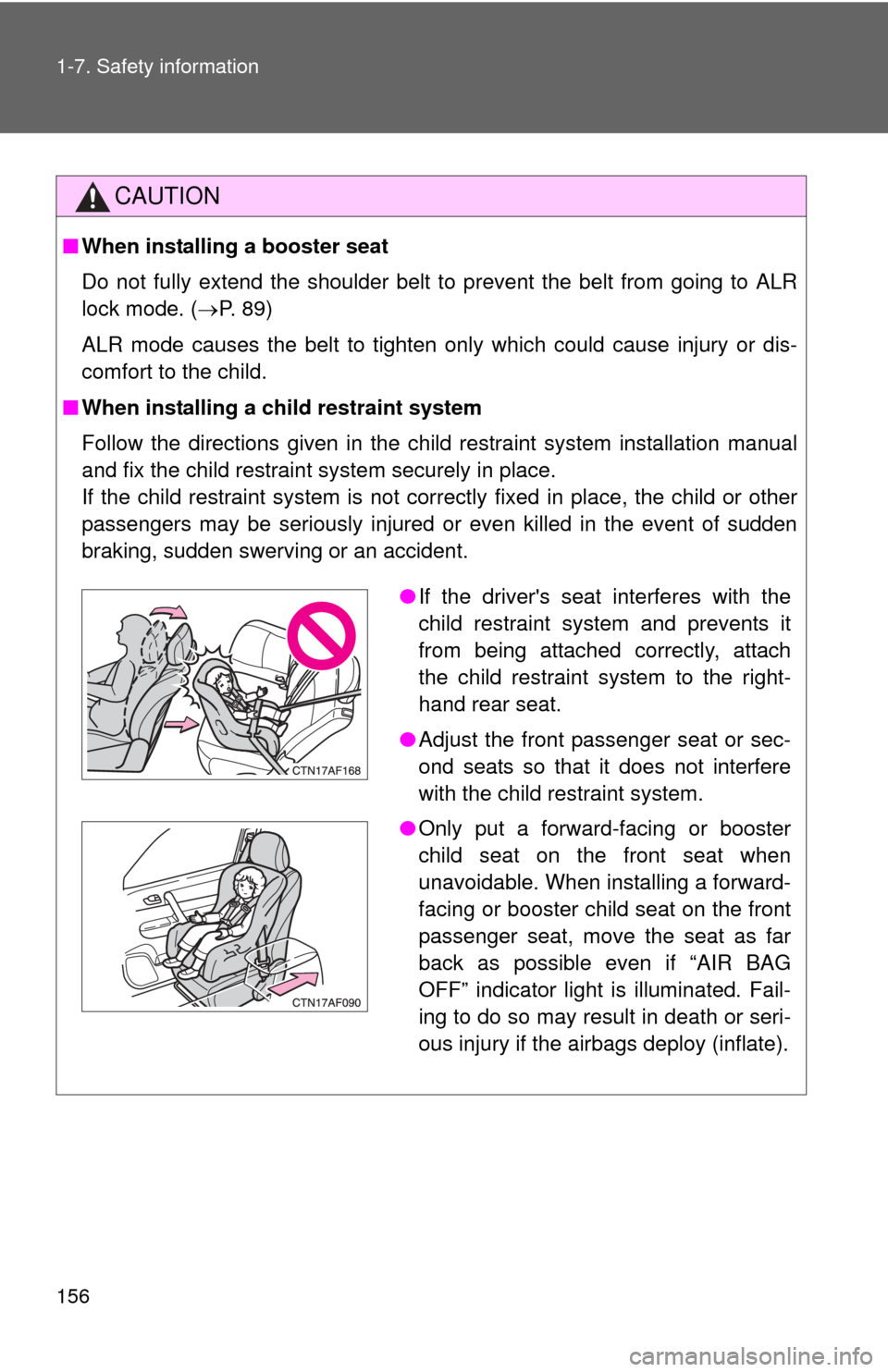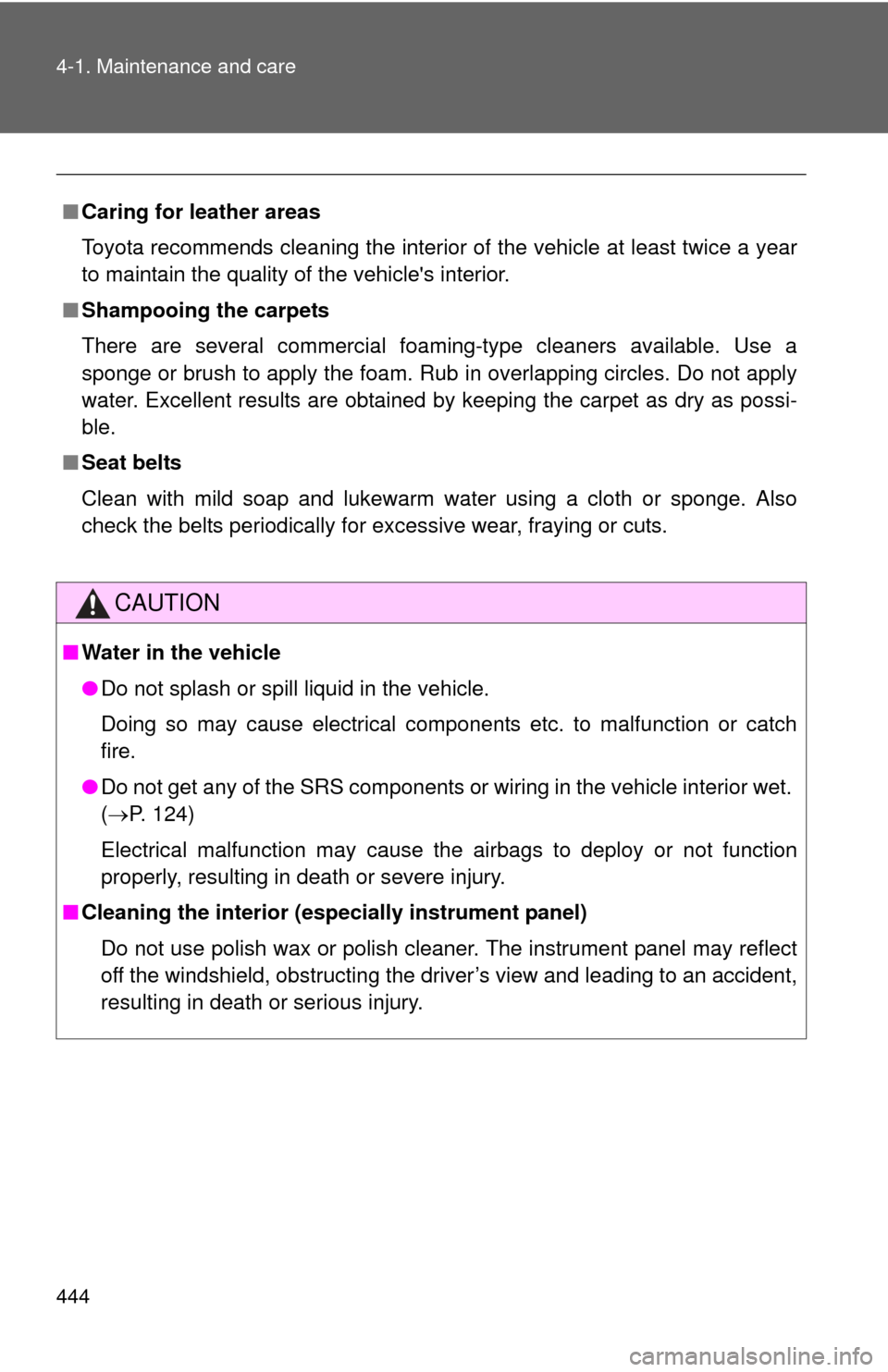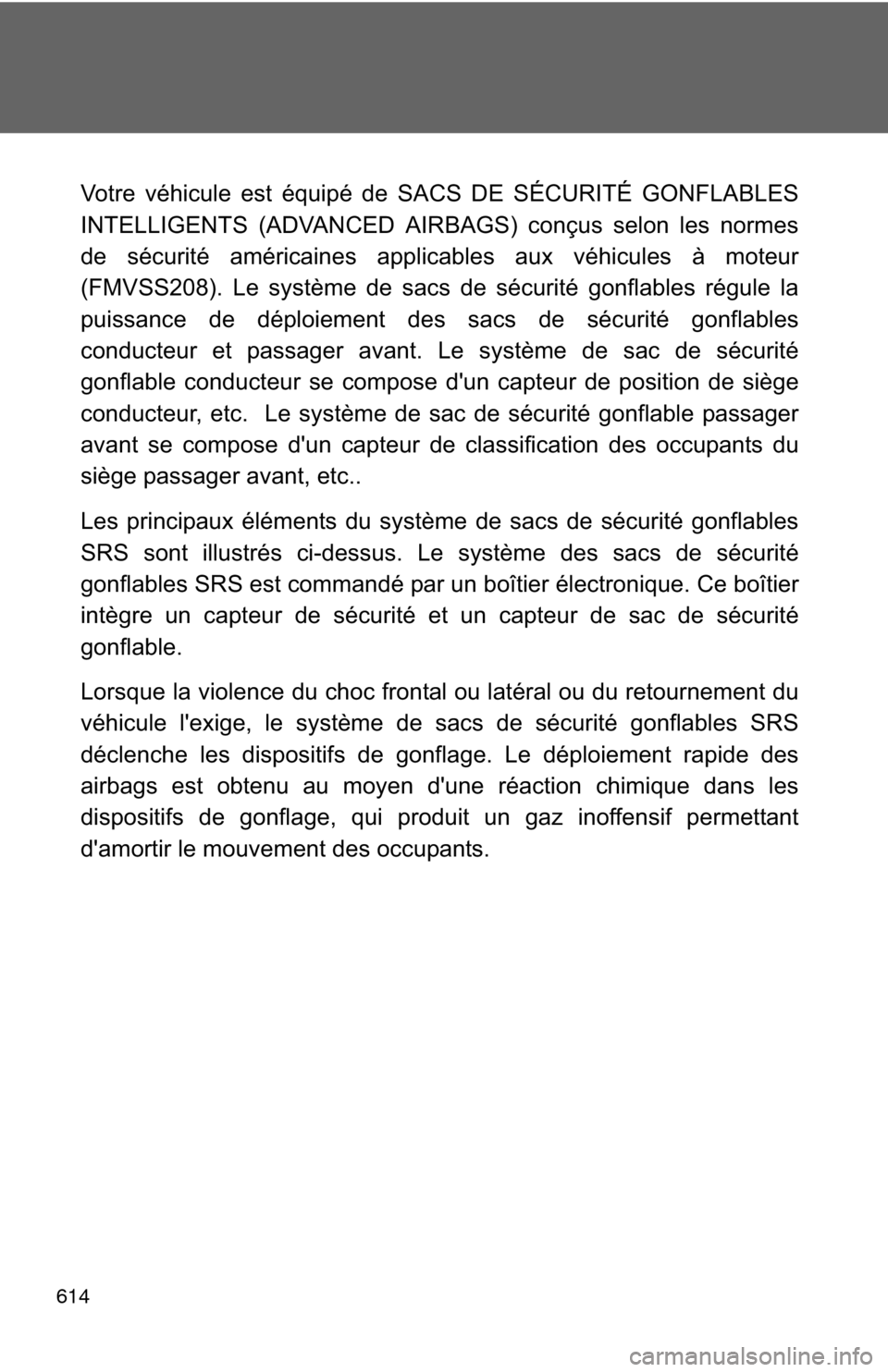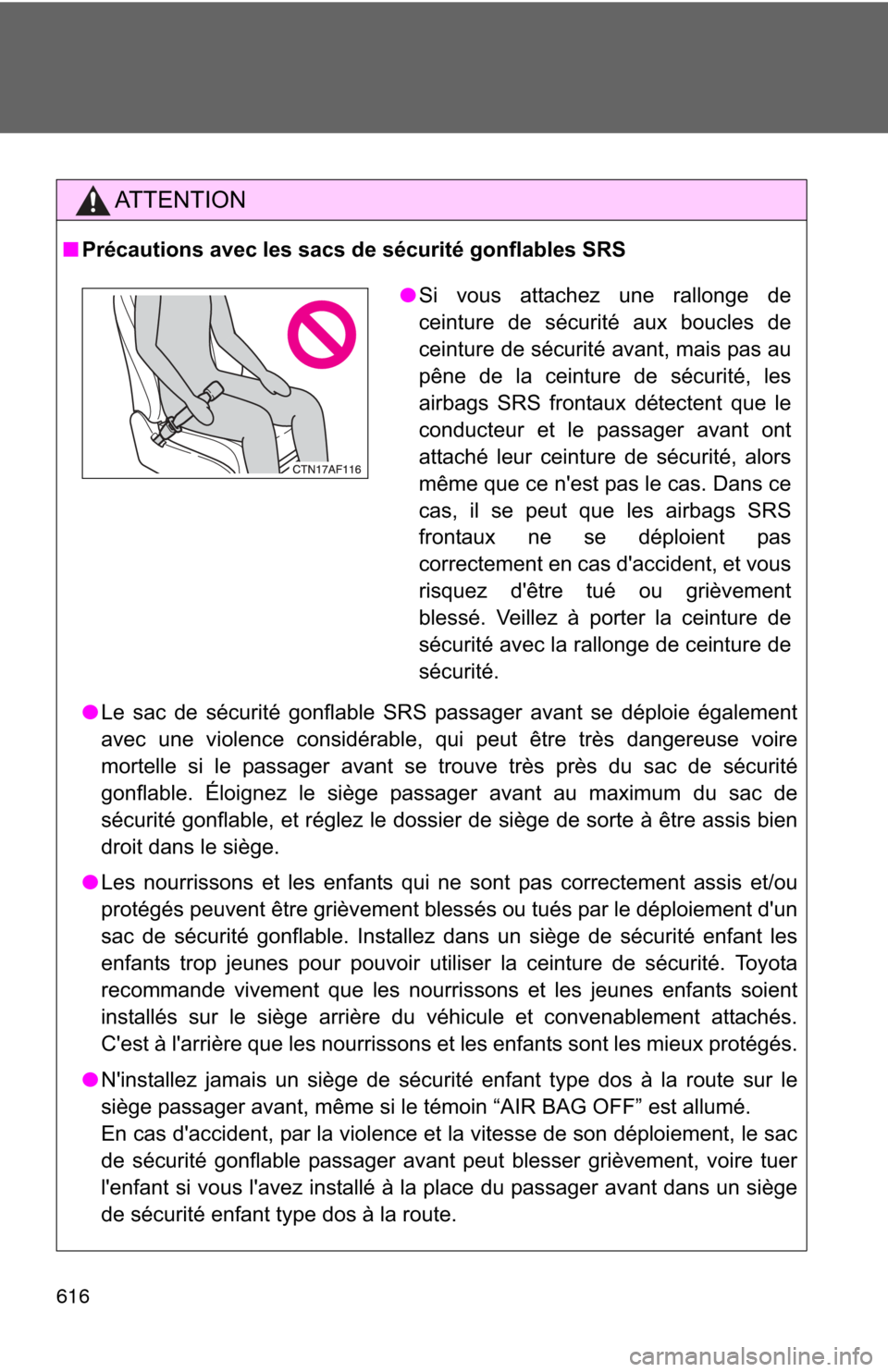2012 TOYOTA HIGHLANDER airbag off
[x] Cancel search: airbag offPage 145 of 636

145
1-7. Safety information
1
Before driving
CAUTION
■
Child restraint precautions
●A forward-facing child restraint system may be allowed to be installed on
the front passenger seat only when it is unavoidable. A child restraint sys-
tem that requires a top tether strap should not be used in the front passen-
ger seat since there is no top tether strap anchor for the front passenger
seat. Adjust the seatback as uprights as possible and always move the
seat as far back as possible even if the “AIR BAG OFF” indicator light is
illuminated, because the front passenger airbag could inflate with consid-
erable speed and force. Otherwise, the child may be killed or seriously
injured.
● Do not use the seat belt extender when installing a child restraint system
on the front or rear passenger seat. If installing a child restraint system
with the seat belt extender connected to the seat belt, the seat belt will not
securely hold the child restraint system, which could cause death or seri-
ous injury to the child or other passengers in the event of a sudden stop,
sudden swerve or accident.
● Do not allow the child to lean his/her head or any part of his/her body
against the door or the area of the seat , front and rear pillars or roof side
rail from which the side airbags or curtain shield airbags deploy even if the
child is seated in the child restraint system. It is dangerous if the side air-
bags and curtain shield airbags inflate, and the impact could cause death
or serious injury to the child.
● Make sure you have complied with all installation instructions provided by
the child restraint manufacturer and that the system is properly secured. If
it is not secured properly, it may cause death or serious injury to the child
in the event of a sudden stop, sudden swerve or accident.
■ When children are in the vehicle
Do not allow children to play with the seat belt. If the seat belt becomes
twisted around a child’s neck, it may lead to choking or other serious injuries
that could result in death.
If this occurs and the buckle cannot be unfastened, scissors should be used
to cut the belt.
Page 156 of 636

156 1-7. Safety information
CAUTION
■When installing a booster seat
Do not fully extend the shoulder belt to prevent the belt from going to ALR
lock mode. ( P. 89)
ALR mode causes the belt to tighten only which could cause injury or dis-
comfort to the child.
■ When installing a child restraint system
Follow the directions given in the child restraint system installation manual
and fix the child restraint system securely in place.
If the child restraint system is not correctly fixed in place, the child or other
passengers may be seriously injured or even killed in the event of sudden
braking, sudden swerving or an accident.
●If the driver's seat interferes with the
child restraint system and prevents it
from being attached correctly, attach
the child restraint system to the right-
hand rear seat.
● Adjust the front passenger seat or sec-
ond seats so that it does not interfere
with the child restraint system.
● Only put a forward-facing or booster
child seat on the front seat when
unavoidable. When installing a forward-
facing or booster child seat on the front
passenger seat, move the seat as far
back as possible even if “AIR BAG
OFF” indicator light is illuminated. Fail-
ing to do so may result in death or seri-
ous injury if the airbags deploy (inflate).
Page 189 of 636

189
2-2. Instrument cluster
2
When driving
*1: These lights turn on when the engine switch is turned to the “ON”
position (vehicles without smart key system) or the “ENGINE
START STOP” switch is turned to IGNITION ON mode (vehicles
with smart key system) to indicate that a system check is being per-
formed. They will turn off after the engine is started, or after a few
seconds. There may be a malfunction in a system if a light does not
come on, or if the lights do not turn off. Have the vehicle inspected
by your Toyota dealer for details.
*2: The light flashes to indicate that the system is operating.
■ Warning lights
Warning lights inform the driver of malfunctions in any of the
vehicle’s systems. ( P. 528)
Shift position and shift range indica-
tors ( P. 177)
SRS airbag on-off indi-
cator (P. 135)
Enhanced VSC off indi-
cator
(P. 225)
(if equipped)
Cruise control indicator
( P. 215)
(if equipped)
Engine immobilizer/
alarm indicator
(P. 113, 116)“TRAC OFF” indicator
( P. 224)
(Canada)(U.S.A.)(Canada)(U.S.A.)(Canada)
(U.S.A.)(U.S.A.)
(if equipped)
*1
*1
*1
*1*1*1*1, 2*1*1*1*1
*1*1, 2*1*1*1, 2*1, 2
*4*5*3*1*6
Page 190 of 636

190 2-2. Instrument cluster
CAUTION
■If a safety system warning light does not come on
Should a safety system light such as the ABS and SRS airbag warning light
not come on when you start the engine, this could mean that these systems
are not available to help protect you in an accident, which could result in
death or serious injury. Have the vehicle inspected by your Toyota dealer
immediately if this occurs.
*1: These lights turn on when the engine switch is turned to the “ON”
position (vehicles without smart key system) or the “ENGINE
START STOP” switch is turned to IGNITION ON mode (vehicles
with smart key system) to indicate that a system check is being per-
formed. They will turn off after the engine is started, or after a few
seconds. There may be a malfunction in a system if a light does not
come on, or if the lights do not turn off. Have the vehicle inspected
by your Toyota dealer for details.
*2: Vehicles without multi-information display
*3: Vehicles with multi-information display
*4: Vehicles without navigation system
*5: Vehicles with navigation system
*6: The light flashes to indicate a malfunction.
Page 444 of 636

444 4-1. Maintenance and care
■Caring for leather areas
Toyota recommends cleaning the interior of the vehicle at least twice a year
to maintain the quality of the vehicle's interior.
■ Shampooing the carpets
There are several commercial foaming-type cleaners available. Use a
sponge or brush to apply the foam. Rub in overlapping circles. Do not apply
water. Excellent results are obtained by keeping the carpet as dry as possi-
ble.
■ Seat belts
Clean with mild soap and lukewarm water using a cloth or sponge. Also
check the belts periodically for excessive wear, fraying or cuts.
CAUTION
■Water in the vehicle
●Do not splash or spill liquid in the vehicle.
Doing so may cause electrical components etc. to malfunction or catch
fire.
● Do not get any of the SRS components or wiring in the vehicle interior wet.
( P. 124)
Electrical malfunction may cause the airbags to deploy or not function
properly, resulting in death or severe injury.
■ Cleaning the interior (esp ecially instrument panel)
Do not use polish wax or polish cleaner. The instrument panel may reflect
off the windshield, obstructing the driver’s view and leading to an accident,
resulting in death or serious injury.
Page 614 of 636

614
Votre véhicule est équipé de SACS DE SÉCURITÉ GONFLABLES
INTELLIGENTS (ADVANCED AIRBAGS) conçus selon les normes
de sécurité américaines applicables aux véhicules à moteur
(FMVSS208). Le système de sacs de sécurité gonflables régule la
puissance de déploiement des sacs de sécurité gonflables
conducteur et passager avant. Le système de sac de sécurité
gonflable conducteur se compose d'un capteur de position de siège
conducteur, etc. Le système de sac de sécurité gonflable passager
avant se compose d'un capteur de classification des occupants du
siège passager avant, etc..
Les principaux éléments du système de sacs de sécurité gonflables
SRS sont illustrés ci-dessus. Le système des sacs de sécurité
gonflables SRS est commandé par un boîtier électronique. Ce boîtier
intègre un capteur de sécurité et un capteur de sac de sécurité
gonflable.
Lorsque la violence du choc frontal ou latéral ou du retournement du
véhicule l'exige, le système de sacs de sécurité gonflables SRS
déclenche les dispositifs de gonflage. Le déploiement rapide des
airbags est obtenu au moyen d'une réaction chimique dans les
dispositifs de gonflage, qui produit un gaz inoffensif permettant
d'amortir le mouvement des occupants.
Page 616 of 636

616
AT T E N T I O N
■Précautions avec les sacs de sécurité gonflables SRS
●Le sac de sécurité gonflable SRS passager avant se déploie également
avec une violence considérable, qui peut être très dangereuse voire
mortelle si le passager avant se trouve très près du sac de sécurité
gonflable. Éloignez le siège passager avant au maximum du sac de
sécurité gonflable, et réglez le dossier de siège de sorte à être assis bien
droit dans le siège.
● Les nourrissons et les enfants qui ne sont pas correctement assis et/ou
protégés peuvent être grièvement blessés ou tués par le déploiement d'un
sac de sécurité gonflable. Installez dans un siège de sécurité enfant les
enfants trop jeunes pour pouvoir utiliser la ceinture de sécurité. Toyota
recommande vivement que les nourrissons et les jeunes enfants soient
installés sur le siège arrière du véhicule et convenablement attachés.
C'est à l'arrière que les nourrissons et les enfants sont les mieux protégés.
● N'installez jamais un siège de sécurité enfant type dos à la route sur le
siège passager avant, même si le témoin “AIR BAG OFF” est allumé.
En cas d'accident, par la violence et la vitesse de son déploiement, le sac
de sécurité gonflable passager avant peut blesser grièvement, voire tuer
l'enfant si vous l'avez installé à la place du passager avant dans un siège
de sécurité enfant type dos à la route.
●Si vous attachez une rallonge de
ceinture de sécurité aux boucles de
ceinture de sécurité avant, mais pas au
pêne de la ceinture de sécurité, les
airbags SRS frontaux détectent que le
conducteur et le passager avant ont
attaché leur ceinture de sécurité, alors
même que ce n'est pas le cas. Dans ce
cas, il se peut que les airbags SRS
frontaux ne se déploient pas
correctement en cas d'accident, et vous
risquez d'être tué ou grièvement
blessé. Veillez à porter la ceinture de
sécurité avec la rallonge de ceinture de
sécurité.